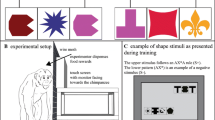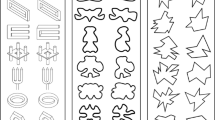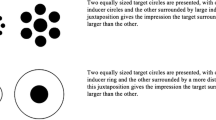Abstract
The processing of Kanizsa-square illusory figures was studied in two experiments with four humans and two chimpanzees. Subjects of the two species were initially trained to select a Kanizsa-square illusory figure presented in a computerized two-alternative forced choice task. After training, adding narrow closing segments to the pacman inducers that composed the Kanisza illusory figures lowered performance in both chimpanzees and humans, suggesting that the discrimination could be controlled by the perception of illusory forms. A second experiment assessed transfer of performance with five sets of figures in which the size of the inducers and their separation were manipulated. Only for chimpanzees was performance directly controlled by separation, suggesting that chimpanzees are more sensitive than humans to the separation between visual elements.
Similar content being viewed by others
Author information
Authors and Affiliations
Additional information
Accepted after revision: 15 August 2001
Electronic Publication
Rights and permissions
About this article
Cite this article
Fagot, J., Tomonaga, M. Effects of element separation on perceptual grouping by humans (Homo sapiens) and chimpanzees (Pan troglodytes): perception of Kanizsa illusory figures. Anim.Cogn. 4, 171–177 (2001). https://doi.org/10.1007/s100710100109
Received:
Published:
Issue Date:
DOI: https://doi.org/10.1007/s100710100109




